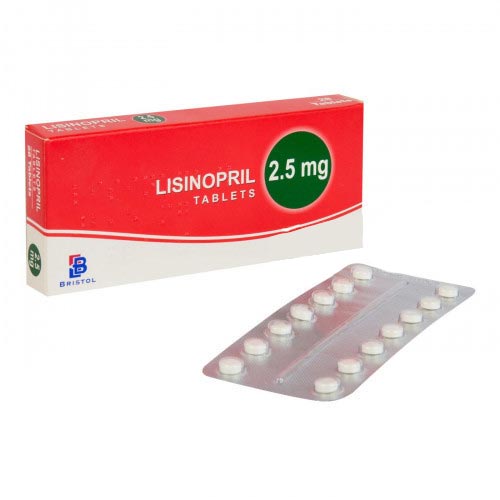Description
Lisinopril is a potent, competitive inhibitor of angiotensin-converting enzyme (ACE), the enzyme responsible for the conversion of angiotensin I (ATI) to angiotensin II (ATII). ATII regulates blood pressure and is a key component of the renin-angiotensin-aldosterone system (RAAS).
Lisinopril may be used to treat hypertension and symptomatic congestive heart failure, to improve survival in certain individuals following myocardial infarction, and to prevent progression of renal disease in hypertensive patients with diabetes mellitus and microalbuminuria or overt nephropathy.
For the treatment of hypertension and symptomatic congestive heart failure. May be used in conjunction with thrombolytic agents, aspirin and/or β-blockers to improve survival in hemodynamically stable individuals following myocardial infarction.
May be used to slow the progression of renal disease in hypertensive patients with diabetes mellitus and microalbuminuria or overt nephropathy.
Pharmacodynamics
Lisinopril is an orally active ACE inhibitor that antagonizes the effect of the RAAS. The RAAS is a homeostatic mechanism for regulating hemodynamics, water and electrolyte balance. During sympathetic stimulation or when renal blood pressure or blood flow is reduced, renin is released from the granular cells of the juxtaglomerular apparatus in the kidneys
In the blood stream, renin cleaves circulating angiotensinogen to ATI, which is subsequently cleaved to ATII by ACE. ATII increases blood pressure using a number of mechanisms. First, it stimulates the secretion of aldosterone from the adrenal cortex. Aldosterone travels to the distal convoluted tubule (DCT) and collecting tubule of nephrons where it increases sodium and water reabsorption by increasing the number of sodium channels and sodium-potassium ATPases on cell membranes. Second, ATII stimulates the secretion of vasopressin (also known as antidiuretic hormone or ADH) from the posterior pituitary gland. ADH stimulates further water reabsorption from the kidneys via insertion of aquaporin-2 channels on the apical surface of cells of the DCT and collecting tubules. Third, ATII increases blood pressure through direct arterial vasoconstriction. Stimulation of the Type 1 ATII receptor on vascular smooth muscle cells leads to a cascade of events resulting in myocyte contraction and vasoconstriction. In addition to these major effects, ATII induces the thirst response via stimulation of hypothalamic neurons.
Mechanism of action
There are two isoforms of ACE: the somatic isoform, which exists as a glycoprotein comprised of a single polypeptide chain of 1277; and the testicular isoform, which has a lower molecular mass and is thought to play a role in sperm maturation and binding of sperm to the oviduct epithelium. Somatic ACE has two functionally active domains, N and C, which arise from tandem gene duplication
Although the two domains have high sequence similarity, they play distinct physiological roles. The C-domain is predominantly involved in blood pressure regulation while the N-domain plays a role in hematopoietic stem cell differentiation and proliferation. ACE inhibitors bind to and inhibit the activity of both domains, but have much greater affinity for and inhibitory activity against the C-domain.
Lisinopril, one of the few ACE inhibitors that is not a prodrug, competes with ATI for binding to ACE and inhibits and enzymatic proteolysis of ATI to ATII. Decreasing ATII levels in the body decreases blood pressure by inhibiting the pressor effects of ATII as described in the Pharmacology section above. Lisinopril also causes an increase in plasma renin activity likely due to a loss of feedback inhibition mediated by ATII on the release of renin and/or stimulation of reflex mechanisms via baroreceptors.
Side effects
All medicines may cause side effects, but many people have no, or minor, side effects.Some medical conditions may interact with Lisinopril.
Tell your doctor or pharmacist if you have any medical conditions.
Most frequent adverse effects include headache, dizziness, cough, fatigue and diarrhea.
This is not a complete list of all side effects that may occur. If you have questions about side effects, contact your health care provider.



Leena Woodlin –
Spot on with this write-up, I seriously believe that this site needs a lot more attention. I’ll probably be back again to read through more, thanks for the advice!
zoritoler imol –
I do agree with all of the ideas you have presented in your post. They’re really convincing and will definitely work. Still, the posts are very short for beginners. Could you please extend them a bit from next time? Thanks for the post.